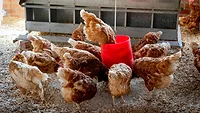Roslin Institute Discovers Genes in Chickens that Could Offer Resistance to Campylobacter

BMC Genomics has published a study from the Roslin Institute, part of the College of Medicine and Veterinary Medicine, University of Edinburgh, which identified genes in chickens that could offer resistance to harmful bacteria commonly found in poultry. This could also inform ways to limit the risk of associated food poisoning in people.
According to the Roslin Institute, the research identified a large number of genes in chicken intestines that may determine whether the birds are resistant to Campylobacter.
Campylobacter causes approximately 1.5 million illnesses each year in the U.S. People can become infected with it by eating raw or undercooked poultry or eating something that touched it. They can also get it by eating other foods, including seafood, meat, and produce; by contact with animals; and by drinking untreated water. Although people infected with Campylobacter usually recover on their own, some need antibiotic treatment.
Campylobacter jejuni, specifically, is the leading cause of bacterial gastroenteritis in humans and the handling or consumption of contaminated poultry meat is a key source of infection.
Roslin Institute researchers studied the global transcriptional response of inbred chicken lines that differ in resistance to C. jejuni colonization at a key site of bacterial persistence. The results from this study could inform research towards breeding chickens that are less likely to carry Campylobacter bacteria and therefore limit the risk to poultry customers.
Mark Stevens, Ph.D., personal chair of microbial pathogenesis at the Roslin Institute, said that Campylobacter is present in more than half of chickens sold, which represents a significant risk to consumers, and breeding poultry resistant to the bacteria is one potential way to tackle this. He also said their research is shedding light on how the genetic makeup of chickens influences their response to the bacteria, which could inform ways to breed poultry resistant to Campylobacter and thereby improve food safety.
The researchers tested the effects of Campylobacter infection on chickens that were bred to be resistant or susceptible to the bacteria. Analysis of gut tissue showed differences in activity of a large number of genes, including some involved in immunity, such as the major histocompatibility complex, and antimicrobial peptides. The variation between these genes in susceptible and resistant chickens might possibly explain their response to Campylobacter.
Looking for quick answers on food safety topics?
Try Ask FSM, our new smart AI search tool.
Ask FSM →








